 Copyright © Michael Richmond.
This work is licensed under a Creative Commons License.
Copyright © Michael Richmond.
This work is licensed under a Creative Commons License.
Using stars for astrometry and photometry
Michael Richmond
Jun 13, 2016
a lunchtime talk given at the Harris Corporation of Rochester
Contents
Astronomers have studied the sky for millenia,
creating ever more accurate catalogs of the stars.
In this short presentation, I will provide
a very brief and incomplete history of some
of the most commonly-used catalogs,
which may help to illustrate the advantages
of some of the most recent additions.
I'll separate two functions of such catalogs:
- astrometry, the art of knowing the POSITION
of a star
- photometry, the art of knowing the BRIGHTNESS
of a star
There are many aspects to each of these categories,
with subtleties and complications galore.
I hope that my brief discussion of a few issues
may stimulate the audience to ask questions, so that
we may spend more time on the aspects of particular
interest to this group.
The really old star catalogues are those
of the Babylonians, Egyptians and Greeks;
for example,
the lost catalog of Hipparchus,
or
the surviving "Almagest" of Ptolemy.
But for most scientific purposes, the first
really accurate and BIG catalogues were
created in the nineteenth century.
Let me highlight two of them:
one providing positions and magnitudes of stars,
the other spectral information.
- Bonner Durchmusterung
-
This catalog -- names simply means "Star Catalog of Bonn, Germany" --
was created over a short period, thanks to the herculean
efforts of several very dedicated men in Bonn.
You can
you can learn the details if you wish,
but, in brief,
over the period 1852 to 1859, Friedrich Argelander, director
of the Bonn Observatory, and his assistants
Thormann, Eduard Schonfeld, and A. Kruger, made nearly a million
individual observations.
Their final catalog, often abbreviated BD,
contains positions and magnitude estimates for 324,198 stars
(each of which was observed at least twice).
It's an amazing feat, especially since Thormann left the group
in 1853.
All the measurements are based on eyeball estimates of the
brightness of stars, and the times when they passed through
a reticle in the eyepiece.
You can look at the contents thanks to SIMBAD.
- Henry Draper catalog
-
Scientists at the Harvard College Observatory
spent decades acquiring spectra of stars all over the
sky using objective prism instruments.
Each spectrum was TINY --- between 1/3 and 1/2 of an inch wide,
and perhaps 1/16 of an inch high.
Here are three spectra, shown much larger than actual size:
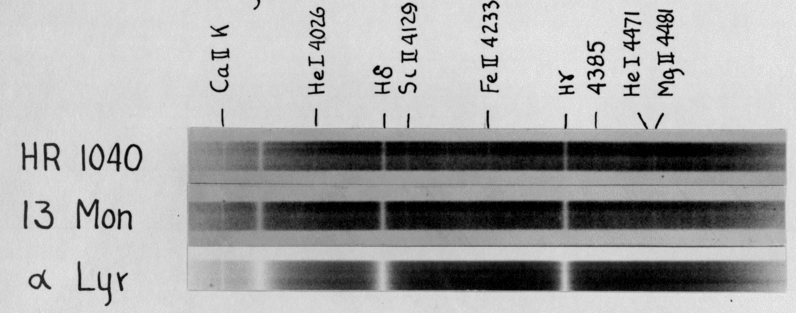
The spectra were used to create a classification system,
which eventually turned into our familiar
MK spectral system: O, B, A, F, G, K, M.
Some details of the work are given at
one of my class webpages.
You can look at the contents thanks to SIMBAD.
Now, just how many stars did these "old" catalogs contain?
To make the numbers a bit more meaningful, let me introduce
one small section of the sky: the bowl of the Big Dipper.
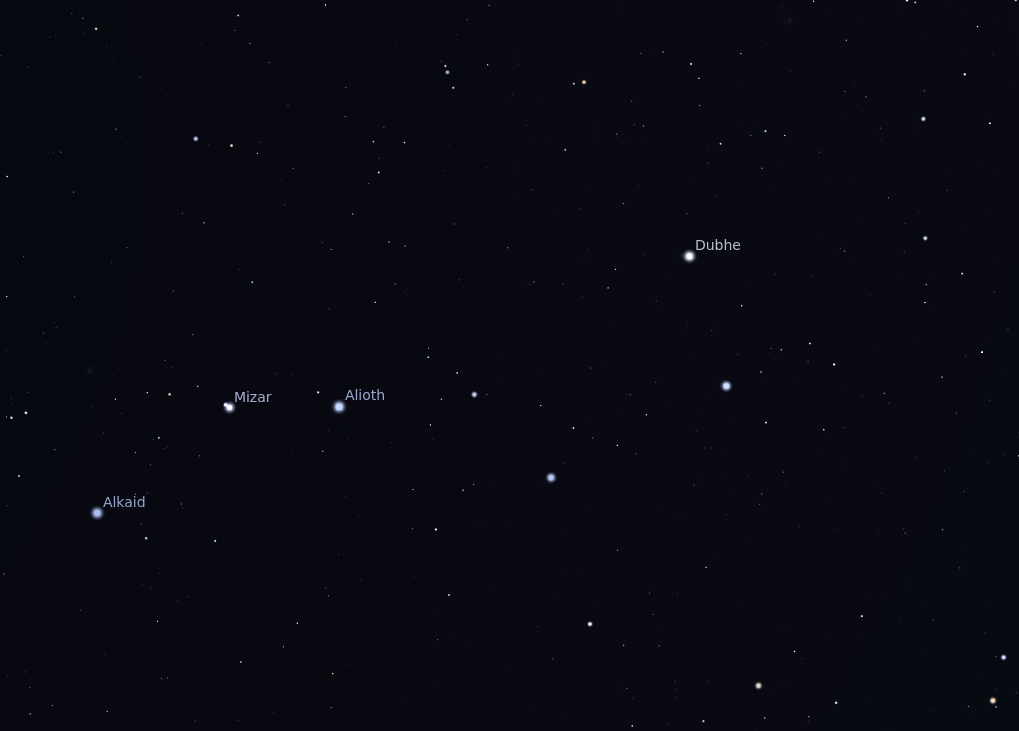
Now, this bowl is a convenient shape and size:
roughly a rectangle, with sides pretty close
to 10 degrees wide and 4 degrees high.
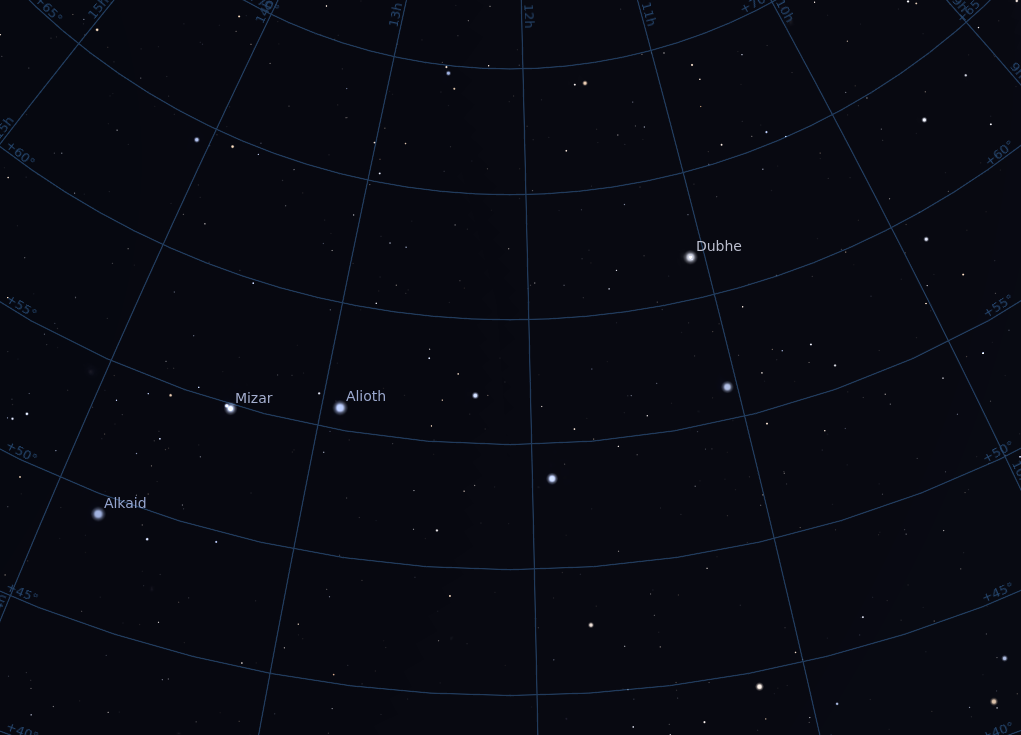
Let me define simple box which is roughly the same
size as the bowl, but which has boundaries which are
easy to describe and use in catalog searches:
- 11 hours < RA < 12 hours
- 55 degrees < Dec < 60 degrees
This box has an area of just about 40 square degrees;
by a nice coincidence, this very roughly 1/1000th
the area of the entire sky.
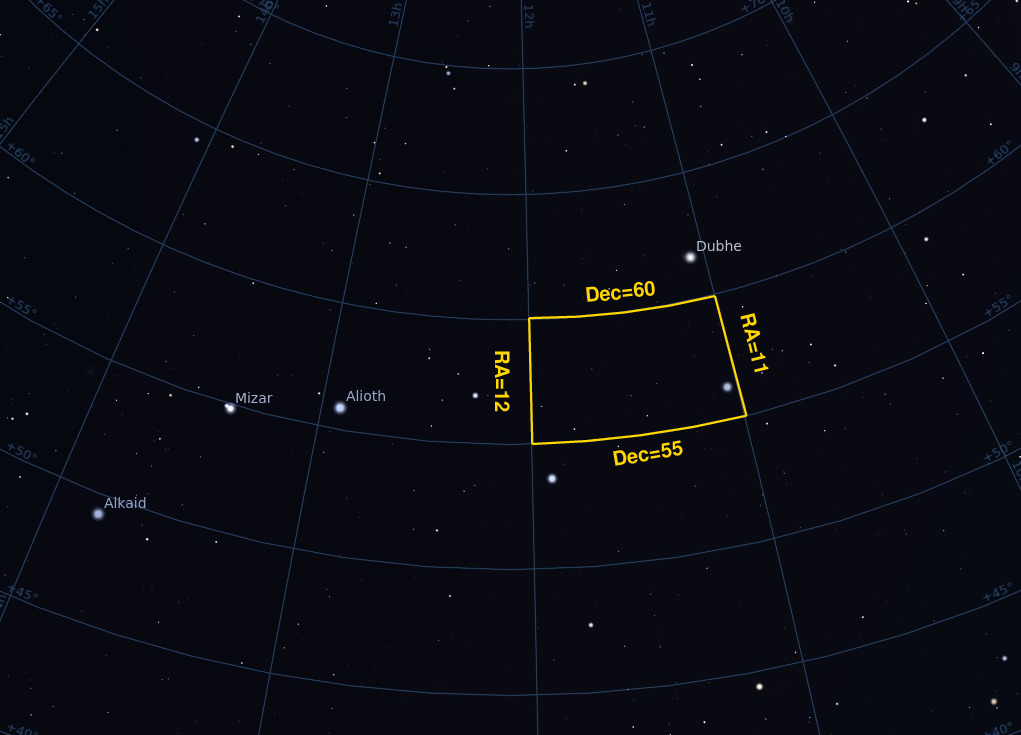
So, how many stars do these "old" catalogs contain
within the boundaries of this box?
catalog stars in box stars/sq.deg. limiting mag
-------------------------------------------------------------------------
Bonner Durchmusterung 305 7.6 9
Henry Draper 181 4.5 9
-------------------------------------------------------------------------
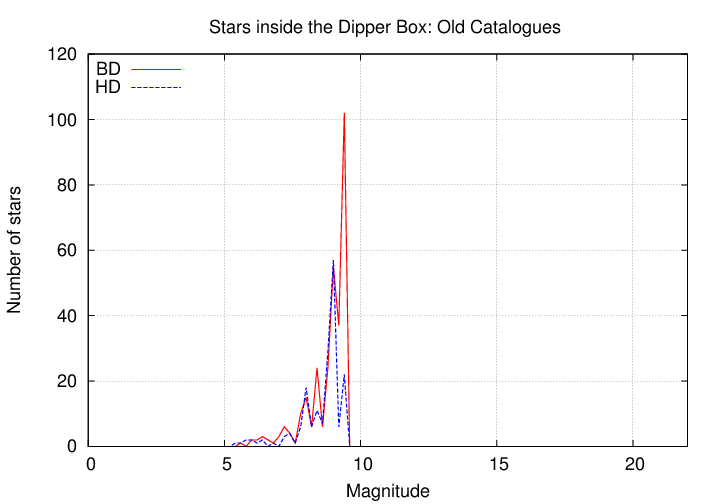
In the mid-to-late twentieth century,
advances in photographic technology allowed astronomers
to record images of stars over the entire sky to
deeper limits,
showing far more stars than could be detected in the past.
Computer-controlled equipment could scan those photographic
plates and measure the properties of millions of stars
in a reasonable amount of time.
The result was a set of new catalogs with
enormous numbers of stars.
In addition, the European Space Agency launched a satellite
mission dedicated to measuring the positions of tens of
thousands of stars with unprecedented accuracy.
The Hipparcos mission
produced positions and proper motions which
made earlier measurements obsolete.
Let's look at just two of the many excellent catalogs
which appeared at this time.
- Guide Star Catalog
-
Scientists planning operations for the Hubble Space Telescope
realized that they would need some way to point the
telescope to arc-second precision, at nearly any location
on the sky. They came up with a plan to scan two epochs
of photographic plates taken as part of the
Palomar Sky Surveys:
- the original survey (POSS-I), taken between 1949 and 1958
- the "Quick V" survey, taken between 1982 and 1984
Based on these two sets of measurements, the authors of
the Guide Star Catalog (GSC)
could determine positions, magnitudes and proper motions for
many stars, enough to provide some references for HST
in almost any region of the sky.
You can look at the contents thanks to SIMBAD.
- Hipparcos Catalog
-
The Hipparcos satellite was unusual: it featured no big
camera to take pretty pictures.
Instead, its two telescopes focused light from
areas of the sky about 58 degrees apart onto a single
detector, allowing the instrument to determine precisely
the angular distance between stars in those widely-separated
areas.
The satellite recorded a continuous strip of measurements
as it spun on its axis, eventually covering the entire
sky many times between 1989 and 1993.
After a very long and involved reduction procedure,
scientists could produce a catalog contain VERY precise
precisions and proper motions for many stars, all over the sky.
The precision of the measurements was, at best,
just a few milli-arcseconds -- better than just about
any ground-based efforts, and far more comprehensive.
You can look at the contents thanks to SIMBAD.
How big were these catalogs?
Well, Hipparcos focused on relatively bright stars,
so it did not exceed in size the older ones
(though it beat the pants off them in accuracy):
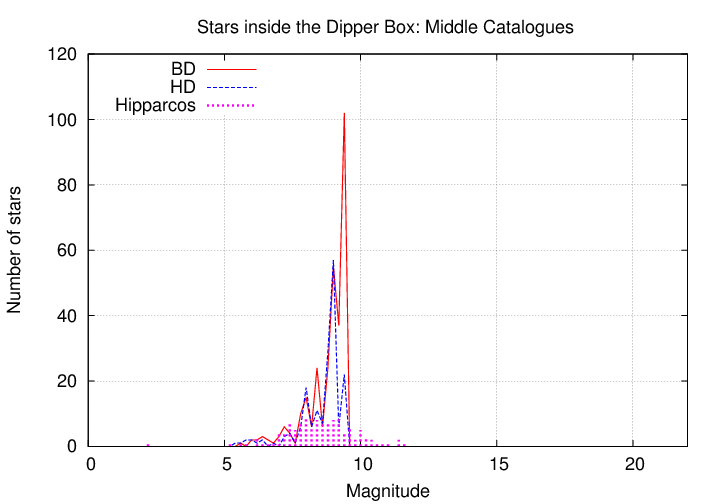
The Guide Star Catalog DID go much deeper than the earlier catalogs.
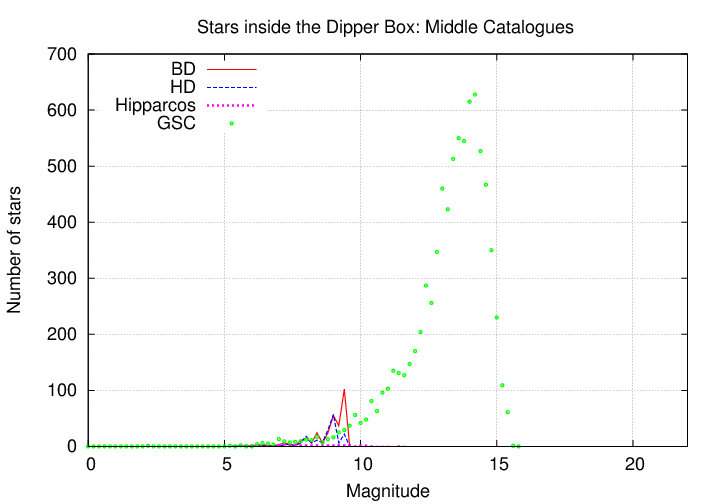
catalog stars in box stars/sq.deg. limiting mag
-------------------------------------------------------------------------
Bonner Durchmusterung 305 7.6 9
Henry Draper 181 4.5 9
Hipparcos 119 3.0 9-10
Guide Star Catalog 8007 20.2 14
-------------------------------------------------------------------------
In the last two decades, astronomers have increased the
scope of their stellar catalogs,
going deeper in the optical,
and extending their reach into the near-infrared portion
of the spectrum.
In addition, some scientists have combined the results
from the optical and infrared to make catalogs which
provide information over a wide spectral range for
each star --
which can allow us to estimate the spectral type
of each star with some precision.
Finally, astronomers are working hard to increase
the absolute calibration
of their measurements of stellar brightness.
- USNO B1.0 catalog
-
Astronomers at the
US Naval Observatory
take their job very seriously: providing materials to help ships
navigate and determine their locations by the stars.
Sure, GPS is nice, but what happens if the satellites are knocked
out, or a ship suffers electrical failures?
One of the many, many catalogs produced by the USNO over the years
is based on scans of the
Second Palomar Sky Survey
taken in the 1980s and 1990s with improved photographic emulsions.
The USNO B1.0 goes to unprecented depths, detecting stars
down to magnitude 20 or 21.
You can look at the contents thanks to SIMBAD.
- Two Micron All Sky Survey (2MASS)
-
In the 1990s, scientists gained access to detectors
sensitive to near-infrared light, originally developed
for military applications.
Now, why should infrared light be so important?
Well, let's look at the standard astronomical broad-band filters,
used in many stellar catalogs.
The Johnson-Cousins UBVRI system includes
five filters covering the visible portion of the spectrum.
These filters do a decent job of spanning the bulk of the
energy emitted by some stars ...
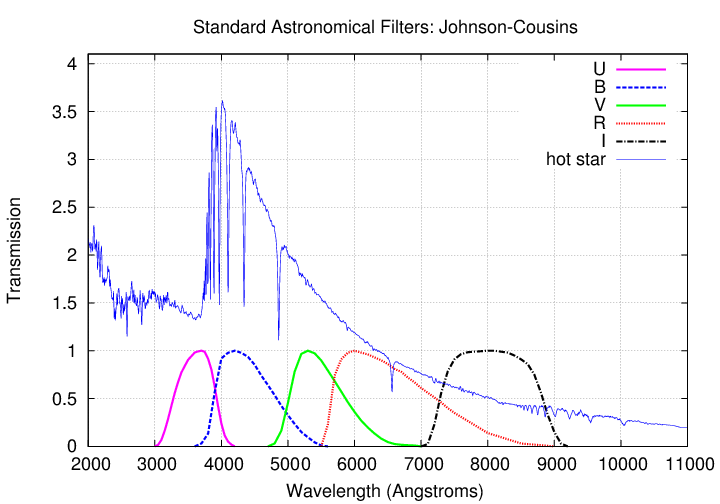
but only catch a very small fraction of the energy
emitted by cool stars. And cool stars are much more common
than the hot ones.
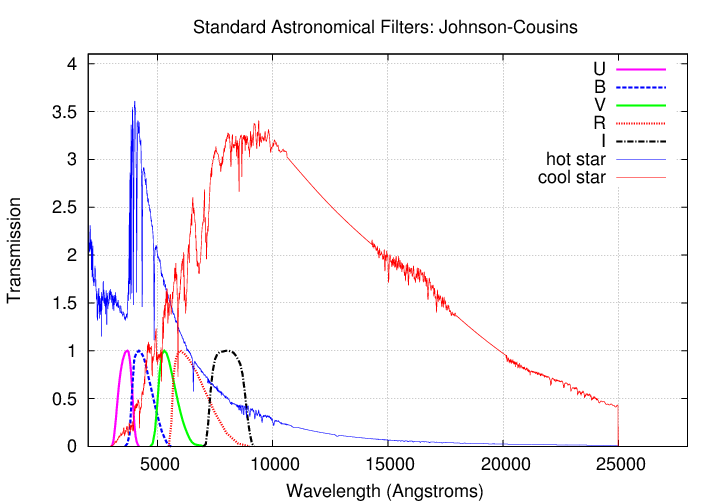
On the other hand, the
JHK system of near-infrared broadband
photometry DOES include much of the light emitted
by cool stars.
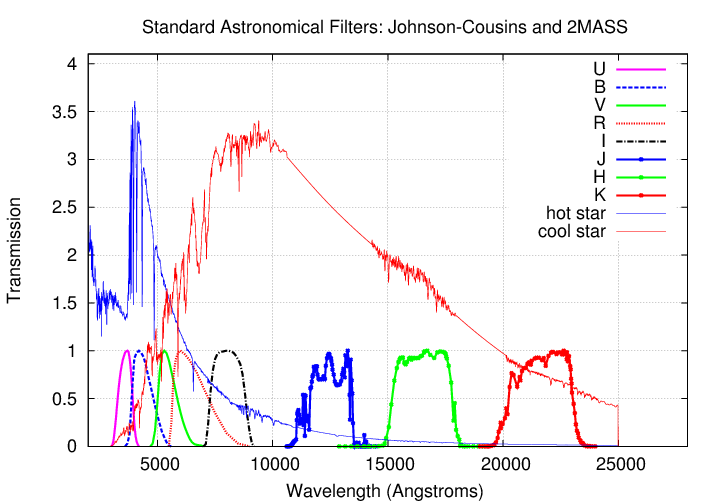
One group of astronomers, led by a team from
the University of Massachusetts,
spent four years (1997 - 2001) scanning the entire sky
with infrared detectors through the JHK passbands,
then several more years analyzing the results.
One of the fruits of their work was
the 2MASS catalog.
You can look at the contents thanks to SIMBAD.
The new catalogs provide HUGE numbers of stars,
increasing the probability that any tiny little area
of interest will include at least several;
or, in other words,
increasing the number of stars falling into the field of view
of some instrument, no matter where it is pointed.

catalog stars in box stars/sq.deg. limiting mag
-------------------------------------------------------------------------
Bonner Durchmusterung 305 7.6 9
Henry Draper 181 4.5 9
Hipparcos 119 3.0 9-10
Guide Star Catalog 8,007 20.2 14
USNO B1.0 305,579 7,640 20
2MASS 63,924 1,600 15
-------------------------------------------------------------------------
The recent combination of
- increased density of stars
- increased wavelength range -- infrared as well as optical
- improved absolute calibration
allows astronomers to do things that may be very
useful to operators of satellites.
For example,
identifying the spectral type
of a star based on its measured magnitudes.
If one has measurements from both the optical and
near-infrared,
and a consistent calibration,
one can match the magnitudes against the values
from a spectral library
to determine the spectral type of a star
very accurately.
- UCAC4 catalog
-
The UCAC4 is another of the many produced by the US Naval Observatory.
This provides optical (B, V, g, r, i) and infrared (J, H, K)
magnitudes for many stars,
as well as proper motions.
While not as deep as some other recent
catalogues, the wide range of wavelengths
allows users to identify particularly hot or cool
stars, which might otherwise appear puzzlingly faint
through some filters.
You can look at the contents thanks to SIMBAD.
-
All-Sky Spectrally Matched UBVRI - ZY and u'g'r'i'z' Magnitudes for Stars in the Tycho2 Catalog
-
Given all this information, Pickles and Depagne used it
to turn the measured MAGNITUDES of millions of stars
across the sky in SPECTRAL TYPES.
They put all the measurements on a consistent scale,
and found the spectral type which best matched all those measurements.
Since a good spectral type allows one to estimate
the absolute luminosity, they were even able to compute
a distance to each of the stars.
You can look at the contents thanks to SIMBAD.
What's so great about having a spectral class for each star
in a catalog?
Well, the key is that
good spectral libraries
allow one to compute any of
- the flux (ergs per sq.cm. per second)
- the number of photons (per sq. cm. per second)
- the magnitude
for a given star.
It's a relatively simple convolution of the
spectrum and the overall sensitivity of the instrument;
the only really complicated part is getting
the zero-points correct for magnitude calculations
(one good reference is
Bessell, PASP 102, 1181, 1990 ,
but there are also
other
useful
references
scattered all over the Internet).
For example, suppose that you measure the
number of photons detected per second
for a couple of stars in the BVRI optical passbands:
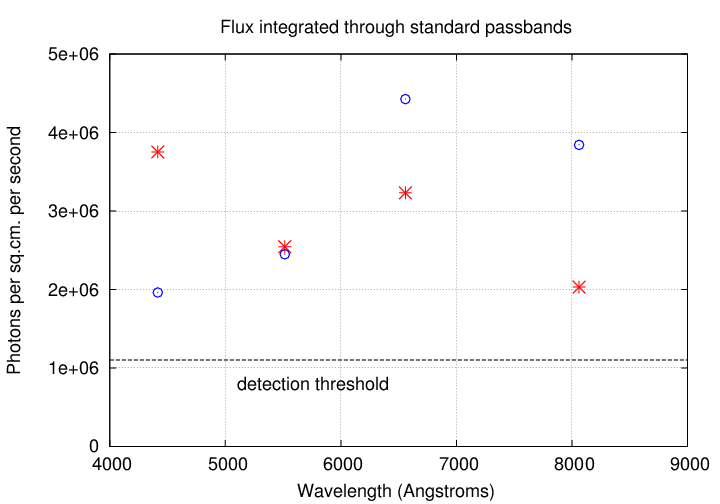
Both stars have plenty of counts through these filters,
easily surpassing the threshold for detection.
But what if you want to find the same stars in the near-infrared?
Which star is a better bet to exceed the threshold at
1.5 or 2.0 microns?
With the help of some of the recent catalogs,
you can just look up the answer;
without them,
you would have to do quite a bit of work:
- use the optical measurements to find the spectral type
- use the spectral type to predict the photon fluxes in the near-IR
In this particular case, it turns out that the star shown
with blue circular symbols is a Sun-like G5 star,
while the star shown with red asterisks is a hot, Vega-like A0 star.
When we look in the near-infrared,
we find out that the Sun-like star is a much better bet:
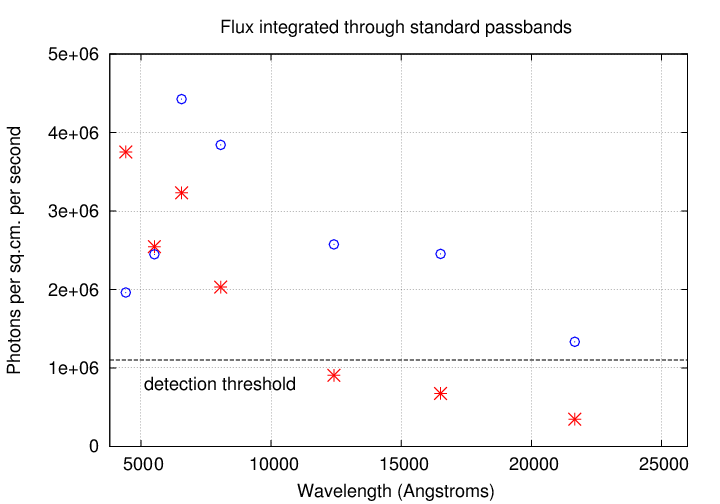
catalog stars in box stars/sq.deg. limiting mag
-------------------------------------------------------------------------
Bonner Durchmusterung 305 7.6 9
Henry Draper 181 4.5 9
Hipparcos 119 3.0 9-10
Guide Star Catalog 8,007 20.2 14
USNO B1.0 305,579 7,640 20
2MASS 63,924 1,600 15
UCAC4 17,286 432 14-15
All-sky Spectral Match 1,171 29.3 12
-------------------------------------------------------------------------
Just in case you want to see what goes into the sausage of
stellar photometric calculations, I'll provide a small
example.
Let's start with the absolutely calibrated spectrum
of a star (which in reality is very, very difficult to acquire!)
and try to figure out its magnitude in the V-band.
We begin with the spectrum and passband transmission function.
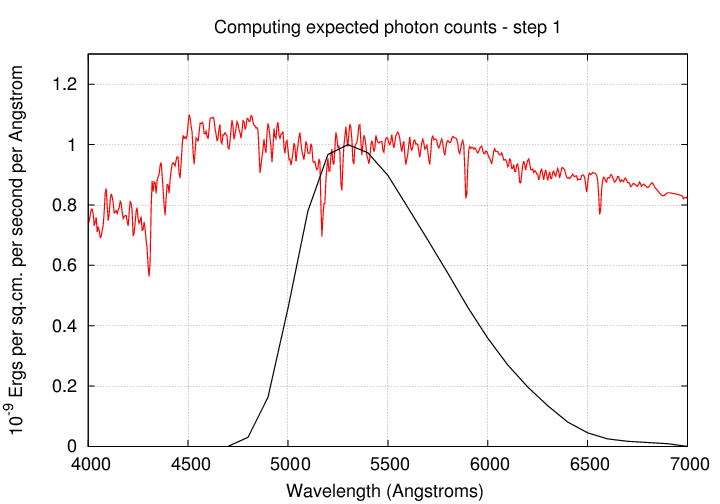
The basic idea is to break the spectrum into tiny little
pieces, small enough that the
spectrum and passband are approximately constant
across each piece.
For example, consider a piece at a wavelength
of 5500 Angstroms.
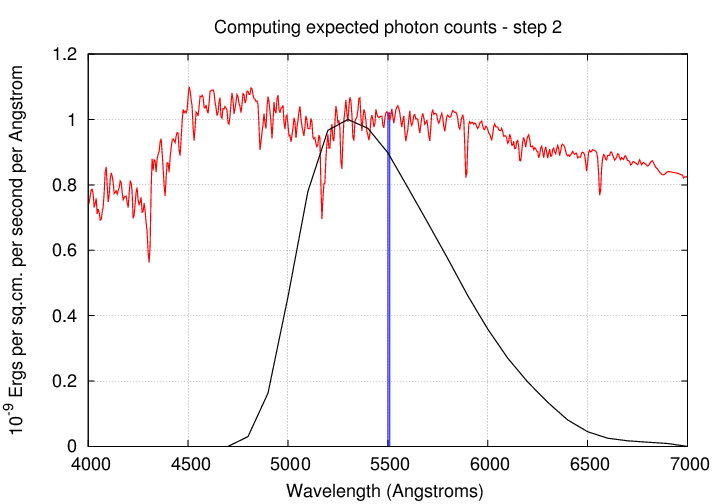
If we zoom in, we can see that choosing
a width of about 10 Angstroms is reasonable.
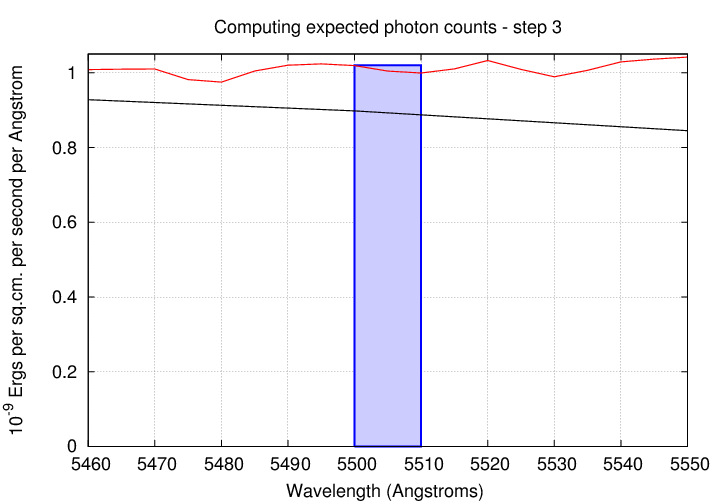
We do the numerical integration inside this little box:

But ergs are hard to measure with some detectors.
Let's convert this to photons, which are often
easier to count.
At the wavelength of 5500 Angstroms,
we know that each photon has an energy of

Using that conversion factor, we end up with
a number of 2.54 x 103 photons per sq.cm. per sec
inside this little piece of the spectrum.
So, we can repeat this process for all the other little
pieces of the spectrum ...
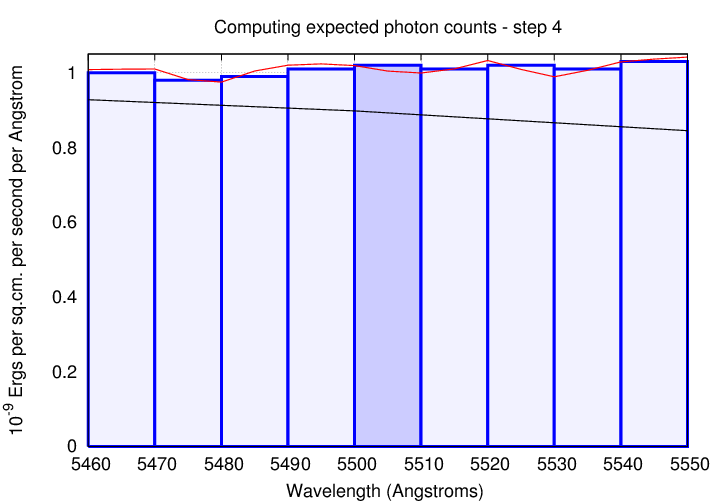
Integrating over all the little pieces,
we end up with

Phew. We are almost done.
The final step is to compute a magnitude from this
number of photon counts.
To do so, we pick a star with a known magnitude
AND a known, calibrated spectrum.
There are very, very few of these -- no more
than 3 or 4.
One of them is the bright star Vega.
The magnitude of Vega in the V-band is
m(Vega) = 0.03.
If we repeat the numerical integration
over that same passband for Vega,
we end up with

Finally, we can derive the magnitude of our star
by comparing the number of photons we collect
from it to the number we collect from Vega:

 Copyright © Michael Richmond.
This work is licensed under a Creative Commons License.
Copyright © Michael Richmond.
This work is licensed under a Creative Commons License.

 Copyright © Michael Richmond.
This work is licensed under a Creative Commons License.
Copyright © Michael Richmond.
This work is licensed under a Creative Commons License.




















